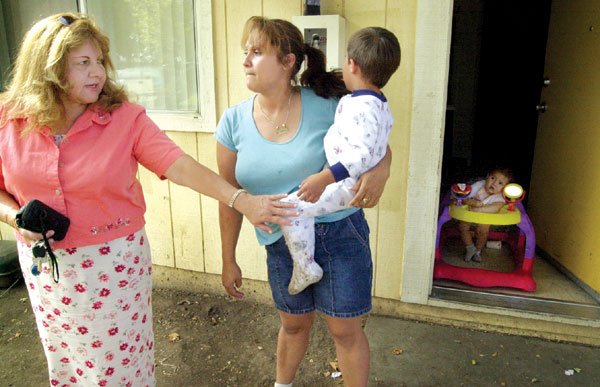GILROY
– Bernadette Barrera grew up in a family that followed
California’s crops, traveling from the south to the north of the
state through the Central Valley twice each year.
By Lori Stuenkel
GILROY – Bernadette Barrera grew up in a family that followed California’s crops, traveling from the south to the north of the state through the Central Valley twice each year.
Having focused on her education after leaving the migrant lifestyle, Barrera now makes regular visits to migrant families as a recruiter for Gilroy Unified School District, connecting them with the many services provided by the migrant education program.
“It’s becoming a really strong advocacy,” said Barrera, who has been with GUSD for four years. “We try to be aware of what’s happening with these children.”
As a recruiter, Barrera is responsible for identifying any students within GUSD who qualify to receive services and outreach from the migrant education program.
“Recruitment is really the heart of the program,” said Lorena Tariba, migrant education program specialist for GUSD. “The recruiter is the person that is out there scouting new families that are moving in, finding people in agricultural areas and camps.”
Migratory youth are children between the ages of 3 and 21 who change schools during the year because their parents cross districts to follow work in agriculture, fishing, dairies or the logging industry. During their time in Gilroy, migrant families often live in organized camps adjacent to farmland.
To flag children for the program, Barrera visits local migrant camps in May, at the start of the peak agricultural season that ends in November. Many families return to Gilroy each year, but new recruits are always coming, Barrera said.
As a trained and licensed recruiter, Barrera is the only GUSD employee who can process paperwork for new cases, Tariba said.
“(Recruiters) need to understand all the little caveats there are for qualifying for the migrant program,” she said. “It’s got to be moving plus other things, they want to make sure they have some kind of quality control.”
Migrant education is a comprehensive program that seeks to level the playing field for migratory youth by closely tracking their educational progress to reduce the disruptions caused by frequent moves and providing outreach for students who are often learning English as a second language.
“Our goal is to make sure the students and families have access to the academic programs and that they take advantage of all these programs available to all the students in the school district, and that they do well at the school,” Tariba said.
The program also connects students with English classes, health clinics, the Santa Clara County Library Bookmobile, dental care and St. Joseph’s Family Center.
In recruiting, Barrera also focuses on engaging parents so their children can get the most out of their time spent in Gilroy schools.
“Many families, most are a percentage who come from Mexico or South America with very little or no education, so education is not a part of their daily life,” Barrera said. “Many (parents) don’t feel comfortable going to meetings or conferences. I tell them, ‘You are an advocator for your children, it’s very important for you to attend meetings, it’s very important for you to get to know your teacher, to volunteer if you can.’ ”
Recruitment is crucial to the success of the program because it is the identification process that generates federal funding.
GUSD’s migrant education program received $348,000 in federal funds this year, based on last year’s enrollment of 1,400 students. Most of that funding supports the program’s personnel who track and manage cases. This year, there are more than 1,500 migrant students in GUSD – the second largest population in a region that spans six counties, from San Francisco and Alameda in the north to San Benito in the south.
Visiting camps and recruiting migratory children requires flexibility and working long hours.
“A lot of it is a labor of love,” Tariba said. “The staff is really good about being flexible and meeting the needs of the program, because they don’t mind having to make home visits, or working in the summer when it is so hot out.”
Barrera occasionally visits the camps to check up on migrant students and their parents.
“I like to stop by, see if there’s anything they need,” Barrera said. “I make sure they aren’t having any problems in school, make sure they know when the health clinic van comes and just check in on them.”
On a recent visit to Ochoa Camp in southeast Gilroy, Barrera stopped in on Estella Duenas, who has six of eight children in GUSD. Two are also enrolled in special education.
Speaking in Spanish, Barrera greeted Duenas and several small children who ran from the house to greet her. Barrera and Duenas chatted like old friends. Things were going well, Duenas said, the children were behaving themselves for the most part.
Barrera and the migrant education program has helped her family a lot, Duenas said. She has a constant connection to someone within the school district who can help answer any questions, she said.
Barrera, who draws inspiration from Cesar Chavez and Martin Luther King, Jr. feels obligated to help children who are at risk of falling through the cracks in the system.
“One of the blessings of our country is that any child, illegal or not, must receive an adequate education,” Barrera said. “A child might get lost in the loopholes, not get lunch … and that’s where, if we get a call, I go there and advocate.”
Migrant Education Program Coordinator Martha Martinez said that Barrera is a key player in the district’s outreach efforts.
“She brings resources not only to the district but also to the program,” Martinez said. “She has a great rapport with the out-of-school youths (between the ages of 18 and 21), so migrant education expands beyond our k-12 world. It goes out and touches other populations in terms of potential students and reaches their needs.”
Barrera donates school supplies to migrant children. Anyone interested in donating may call
847-2700 ext. 7204.














